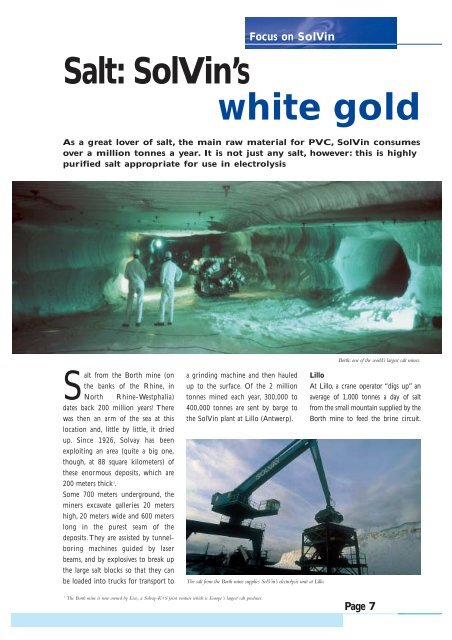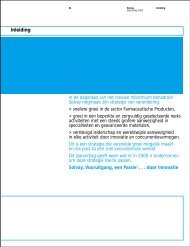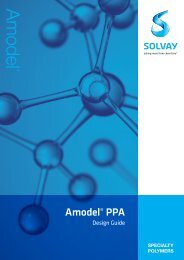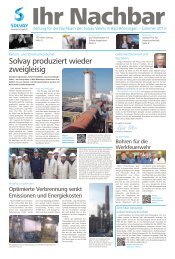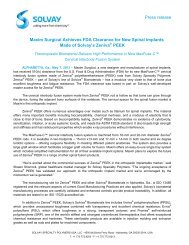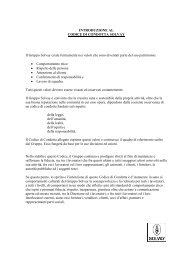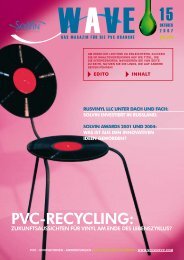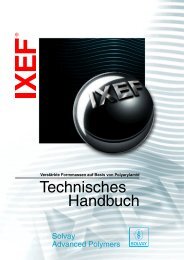Salt - Solvay Plastics
Salt - Solvay Plastics
Salt - Solvay Plastics
You also want an ePaper? Increase the reach of your titles
YUMPU automatically turns print PDFs into web optimized ePapers that Google loves.
Focus on SolVin<br />
<strong>Salt</strong>: SolVin’s<br />
white gold<br />
As a great lover of salt, the main raw material for PVC, SolVin consumes<br />
over a million tonnes a year. It is not just any salt, however: this is highly<br />
purified salt appropriate for use in electrolysis<br />
Borth: one of the world’s largest salt mines.<br />
<strong>Salt</strong> from the Borth mine (on<br />
the banks of the Rhine, in<br />
North Rhine-Westphalia)<br />
dates back 200 million years! There<br />
was then an arm of the sea at this<br />
location and, little by little, it dried<br />
up. Since 1926, <strong>Solvay</strong> has been<br />
exploiting an area (quite a big one,<br />
though, at 88 square kilometers) of<br />
these enormous deposits, which are<br />
200 meters thick 1 .<br />
Some 700 meters underground, the<br />
miners excavate galleries 20 meters<br />
high, 20 meters wide and 600 meters<br />
long in the purest seam of the<br />
deposits. They are assisted by tunnelboring<br />
machines guided by laser<br />
beams, and by explosives to break up<br />
the large salt blocks so that they can<br />
be loaded into trucks for transport to<br />
a grinding machine and then hauled Lillo<br />
up to the surface. Of the 2 million At Lillo, a crane operator “digs up” an<br />
tonnes mined each year, 300,000 to average of 1,000 tonnes a day of salt<br />
400,000 tonnes are sent by barge to from the small mountain supplied by the<br />
the SolVin plant at Lillo (Antwerp). Borth mine to feed the brine circuit.<br />
The salt from the Borth mine supplies SolVin’s electrolysis unit at Lillo.<br />
1<br />
The Borth mine is now owned by Esco, a <strong>Solvay</strong>-K+S joint venture which is Europe’s largest salt producer.<br />
Page 7
Focus on SolVin<br />
Exploiting the salt deposits by drilling<br />
400<br />
Height in meters<br />
ground<br />
old drilling<br />
sites<br />
injection of<br />
fresh water<br />
Direction in which the deposits are exploited<br />
brine pumped out<br />
300<br />
200<br />
salt<br />
100<br />
insoluble deposits<br />
brine<br />
On the way to undergo electrolysis! Tavaux, <strong>Solvay</strong>’s<br />
largest site, alone consumes 600,000 tonnes of salt a<br />
year.<br />
“We add salt to the brine and send it to a saturator,<br />
which it leaves containing 250 grams<br />
of salt per kilo,” explains Peter Van<br />
Laarhoven, who is in charge of the quality<br />
of electrolysis end-products at Lillo.<br />
“The brine is then refined by adding reagents<br />
that trap the impurities (sulfates,calcium,iron,<br />
etc.) as particles that fall to the bottom of the<br />
tank, and we remove them. After that, the<br />
brine goes through filters to remove the last<br />
impurities; it is warmed by heat exchangers,<br />
and finally reaches the electrolysis unit.”<br />
Some of the salt contained in the brine<br />
is consumed to produce chlorine and<br />
caustic soda. The brine that leaves the<br />
electrolysis unit, now with a salt content<br />
of only 180 grams per kilo, is treated to<br />
remove the surplus dissolved chlorine,<br />
and then goes back to the beginning,<br />
with salt being added for another round.<br />
Ludwigshafen<br />
Rock salt has been extracted by the<br />
Südwestdeutsche Salzwerke company<br />
from the mine at Heilbronn for over<br />
180 years.The salt comes from a depth<br />
of about 200 meters, in deposits over<br />
200 millions years old. It is processed<br />
similarly to what happens at Borth, and<br />
has been used for over 130 years at the<br />
Ludwigshafen site. The high-quality<br />
rock salt is carried there in barges that<br />
can hold 1,800 tonnes of blocks. After<br />
a voyage of almost 10 hours along the<br />
Neckar and the Rhine, the salt is<br />
unloaded at an open-air storage area. It<br />
is dissolved and purified, the brine then<br />
being conveyed by pipeline to the<br />
electrolysis unit.<br />
Martorell<br />
<strong>Salt</strong> can also come from potash mines.<br />
This is the case with salt from Suria<br />
(northern Spain), which supplies the<br />
electrolysis unit at Martorell. “Once the<br />
company Iberpotash, which operates the<br />
mine, has extracted the salt from the potash,<br />
it is purified on site by <strong>Solvay</strong> Química and<br />
then sent by train to Martorell,” explains<br />
Manuel Ampudia, who is in charge of<br />
electrolysis at Martorell. “We recently<br />
invested 6 million euros in modernizing the<br />
installations at Suria, in order to obtain still<br />
purer salt. This should mean that the<br />
Martorell electrolysis unit produces less<br />
residue, and that the plant’s environmental<br />
performance is improved.”<br />
When it leaves the Suria mine, the salt is separated from the potash and mixed with brine to obtain a slurry,<br />
which is then washed.The salt crystals are subsequently ground up to facilitate removal of the impurities concealed<br />
inside.After washing for a second time, the slurry undergoes a number of further cleaning operations and then<br />
reaches a band filter, where it is finally separated from the brine, and the latter is recycled.<br />
Tavaux<br />
It is not always possible – or may not<br />
be cost-effective – to excavate mines.<br />
When this is the case, salt can still be<br />
Page 8
Focus on SolVin<br />
extracted by drilling. The salt at<br />
Poligny (Franche-Comté, France) is,<br />
like the Borth deposits, 200 millions<br />
years old, and is at a depth of 150-200<br />
meters, accessible by drilling. Fresh<br />
water is injected to dissolve the salt,<br />
and also to separate it from the clays<br />
with which it is mixed. The saturated<br />
brine is then pumped up and sent by<br />
pipeline to the Tavaux site.<br />
Once the impurities have been<br />
removed, the brine can be crystallized<br />
(salt crystals being precipitated). An<br />
This pipeline carries brine from Poligny almost<br />
40 km to Tavaux, simply by gravity.<br />
aerial conveyor transports the salt produced<br />
to the electrolysis unit, where it<br />
is redissolved, in demineralized water.<br />
Jemeppe-sur-Sambre and<br />
Zandvliet<br />
The drilling site at Epe (west Rhine-<br />
Westphalia, Germany) supplies both<br />
the Zandvliet and Jemeppe-sur-<br />
Sambre sites 2 , the latter involving a<br />
brine pipeline of no less than 240 km!<br />
As at Tavaux, the brine is finally purified<br />
in a “saltworks”. “It is heated by<br />
means of steam in heat exchangers, and<br />
brought to boiling point in a first evaporator,”<br />
explains Philippe Migeot, who is<br />
in charge of electrolysis at Jemeppe.<br />
“As it passes through a number of evaporators,<br />
the brine becomes a thick ‘soup’, which<br />
is allowed to settle and then dried.The ‘wet<br />
salt’ that leaves contains no more than 3%<br />
of water, and is 99.9 % pure.” The<br />
Jemeppe saltworks has sufficient capacity<br />
to meet not only the site’s own<br />
needs but also those of the Zandvliet<br />
electrolysis unit (to which the salt is<br />
dispatched by barge, via the port of<br />
Antwerp).<br />
❑<br />
Grains of salt<br />
Brine from drilled salt<br />
• <strong>Salt</strong> – or sodium chloride (NaCl) –<br />
is not used just to season food! It<br />
is used to produce numerous<br />
chemicals, for de-icing of roads,<br />
and for water softening, etc.<br />
• PVC is made up from 57% salt<br />
and 43% oil.To make 1 tonne of<br />
chlorine (itself used to produce<br />
VCM, and then PVC), you need<br />
1.7 tonnes of salt.<br />
• <strong>Salt</strong> reserves are tremendous.The<br />
substance is found in abundant<br />
quantities in seawater (about 30<br />
grams per liter), and underground<br />
in crystalline form, when it is<br />
known as “rock salt”.<br />
• Worldwide, we consume 26<br />
million tonnes of salt a year:<br />
6 million in Europe.<br />
Settling tank at the Tavaux saltworks.<br />
2 <strong>Solvay</strong>’s Rheinberg plant also receives salt from this drilling site, but its electrolysis unit does not supply chlorine to SolVin.<br />
Page 9
Focus on SolVin<br />
Fundamental<br />
research:<br />
SolVin’s contribution<br />
PVC molecular chain.<br />
It is not easy to improve a material’s intrinsic qualities, and yet this is<br />
just what some players in the PVC industry, by far not all, are trying to<br />
do, convinced that investment in fundamental research is needed to<br />
ensure the future for PVC<br />
Contrary to certain received<br />
ideas, fundamental research<br />
into PVC is alive and well.<br />
“In the first decades of the PVC production,<br />
it was sufficient to exploit the original<br />
strengths of PVC. A variety of applications<br />
were developed and ensured a<br />
growing market,” acknowledged<br />
Vincent Bodart, an expert in radical<br />
polymerization at <strong>Solvay</strong>’s Nederover-Heembeek<br />
(NOH, Brussels)<br />
research center. “While research into<br />
PVC throughout an interim period was<br />
essentially geared to perfecting industrial<br />
processes, the other plastic materials moved<br />
on. In particular, new catalysts (chemicals<br />
that stimulate the reaction by which a<br />
plastic is manufactured) were developed<br />
that improved the properties of polyolefins.<br />
Today we need to assure the further development<br />
of PVC by a far greater effort”.<br />
Faced with competition from other<br />
materials, and with criticisms relating<br />
to certain PVC additives, the industry<br />
reacted by launching new programs<br />
of fundamental research. The aim, of<br />
course, was to enhance the qualities of<br />
PVC, so as to retain the material’s<br />
existing markets and develop some<br />
new ones.<br />
Unity is strength!<br />
To increase the chances of achieving<br />
success from their research, 20 or so of<br />
the world’s producers of PVC (including<br />
<strong>Solvay</strong>) or of additives decided late<br />
in 1998 to form a consortium for the<br />
joint financing of 12 programs. These<br />
were to be managed by the Edison<br />
Polymer Innovation Corporation<br />
(EPIC), an association encouraging<br />
contacts between universities and industrial<br />
firms active in the polymer field,<br />
with American research laboratories<br />
carrying out the programs.<br />
The action being taken is intended to<br />
deal with structural weakness in the<br />
PVC.The fact is that PVC suffers from<br />
thermal instability because of small<br />
defects in the molecular structure,<br />
which is why stabilizers are needed. If<br />
we were able to prevent these imperfec-<br />
About 20 producers of PVC or of additives are jointly financing 12 research programs.The consortium has a budget of several millions dollars per year.<br />
Here we see two scientists from the Neder-over-Heembeek research center.<br />
Page 10
Focus on SolVin<br />
tions in the structure, PVC could be<br />
used at higher temperatures and would<br />
thus be able to enter new markets. It<br />
could, for example, be used for injection<br />
molding of large components. Another<br />
area where there is scope for improvement<br />
is that the temperatures at which<br />
rigid PVC can be used are limited.This<br />
precludes certain applications such as<br />
pipes for hot water supply. Also, the<br />
volatile nature of the plasticisers in flexible<br />
PVC tends to result in the objects<br />
losing flexibility as they age. One solution<br />
could be the development of new<br />
copolymer resins (incorporating other<br />
materials into the PVC).<br />
There are currently two approaches that<br />
particularly interest the researchers, and<br />
some patent applications have already<br />
been made:<br />
- modifying the radical mechanism: in<br />
other words acting on the molecular<br />
structure of PVC to reduce its imperfections;<br />
- changing the polymerization mechanism<br />
by discovering new catalysts.<br />
Once the basic research is finished, the<br />
consortium members are responsible for<br />
validating the laboratory results and seeing<br />
whether it is possible to convert<br />
them into industrial processes. That is<br />
what the scientists at <strong>Solvay</strong>’s NOH<br />
research center have been doing since<br />
December 2001. They are working on<br />
controlled radical polymerization 1 and,<br />
Mr Bodart says, “within two to three years<br />
we will know whether it was worthwhile<br />
going down that road.There are a lot of hazards,<br />
but I think that today’s fundamental<br />
research will bear fruit within 10 years.”<br />
❑<br />
Organization of research at SolVin<br />
Some of SolVin’s researchers.The separation between development and basic research demonstrates SolVin’s desire<br />
to give emphasis to the long term.When the two are dealt with together, the short-term issues tend to get more<br />
attention, because its concerns are often perceived more urgent.<br />
construction materials. The department<br />
is also working to improve the mechanical<br />
properties of PVC. “By mixing PVC<br />
with ultrafine inorganic fillers (to obtain<br />
“nanocomposites”), we would be able to get<br />
a material that is more rigid while retaining<br />
great shock-resistance,” explained Jean-<br />
Marc Coisne, the department’s head.<br />
“We have the first interesting results, but<br />
developing them to the stage where they can<br />
be applied industrially is still likely to take<br />
many years.”<br />
❑<br />
SolVin together with <strong>Solvay</strong> is concerned<br />
to carry out development as well<br />
as basic research programs. The SolVin<br />
scientists are collaborating closely with<br />
<strong>Solvay</strong>’s, and are split into three departments<br />
based at the Brussels research<br />
center:<br />
- Research & Development<br />
- Research & Technology – suspension<br />
PVC<br />
- Research & Technology – emulsion<br />
PVC.<br />
In addition, pilot plants at the Jemeppesur-Sambre<br />
and Ludwigshafen sites are<br />
carrying out tests on a semi-industrial<br />
scale.<br />
“In our department, we are further improving<br />
the existing applications, and trying to develop<br />
new ones. For example,‘decking’ (boards<br />
for the garden or for port jetties, etc.) and pallets<br />
made of PVC profiles are being developed<br />
in collaboration with the converters,”<br />
says Joël Fumire, head of R&T<br />
Suspension PVC. “They could be on the<br />
market within three years.” Their advantages<br />
compared to the timber generally<br />
used in Europe are that they are waterproof<br />
(not absorbing water, unlike<br />
wood) and can be disinfected.<br />
The R&D department is working on<br />
improving the fire resistance of PVC,<br />
with a view to responding to a probable<br />
tightening up of the regulations on<br />
Seekers able<br />
to find<br />
In Wave No. 2 (January 2001), we<br />
told you about the new seeded<br />
microsuspension process. SolVin<br />
now makes considerable use of this<br />
technology to produce emulsion<br />
PVC.The new resins allow:<br />
- either a lesser use of plasticiser, to<br />
produce a plastisol (“paste”) with<br />
the usual amount of flexibility,<br />
- or the usual admixture of<br />
plasticiser, to produce plastisols<br />
that are more flexible, and thus<br />
easier to handle.<br />
1 This research corresponds to some of the projects promoted by <strong>Solvay</strong>’s Corporate New Business Development department.<br />
Page 11


